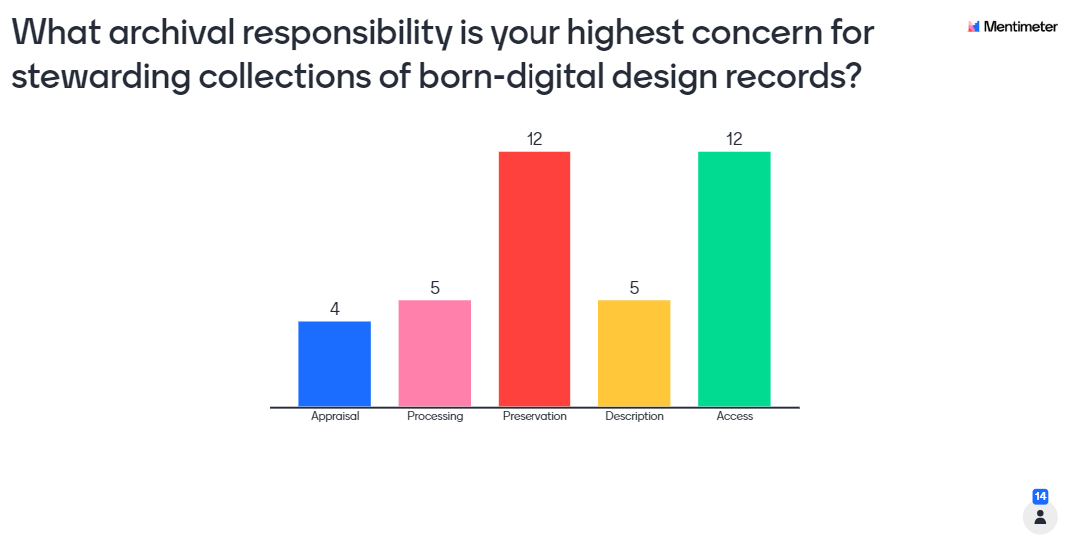On Friday last week we held a #DPClinic session to highlight and celebrate the Technology Watch Report we made available to the wider community earlier this month. In this session, we invited Aliza Leventhal and Jody Thompson to discuss their report on Preserving Born-Digital Design and Construction Records with the community and answer any questions that emerged. We also wanted to use the opportunity to ask some questions of the attendees and find out their perspective on the topic.
We started the session with a short presentation from Aliza and Jody. They talked about the need for the report and the high barriers to engagement for the archival community. They were keen for the report to help both archival professionals but also wanted it to be of use for designers and facility managers. They also discussed the scope of the report - the preservation of design and construction records is such a substantial and complex topic that it was not possible to cover everything. What the report does focus on are the following:
- A brief history of born-digital design software use.
- Key initiatives within the archival community on collecting and understanding born-digital design records.
- Case studies of academic, cultural and corporate institutions with born-digital design collections.
- Summary of current research within the archival community, including known gaps in the literature.
Though it is of course a ‘Technology Watch Report’ the authors noted that it wasn’t hugely technical. It doesn’t go into a huge amount of detail on file types, software companies and products and does not cover 3D scanning and printing or preservation programme recommendations. The focus is deliberately more on the ‘bigger picture’ and on work to identify the challenges and perhaps also to highlight previous efforts that we can learn from.
Note that the following Technology Watch Guidance Notes within the ‘Data Types’ series might be helpful in talking about some of the more technical areas of this topic:
Aliza and Jody shared a timeline of key initiatives relating to this topic and this timeline nicely illustrated the growing pace of work in this area over the last few years. Much of this information is encapsulated in the report itself (with helpful signposts out to relevant resources) and the report will be updated soon to add in some additional resources.
A key element of the report was the case studies, which clearly demonstrated that there is no one-size-fits-all solution to the preservation of these records - the range of organizations mentioned in the case studies demonstrated that there are different levels of resource and capacity to address this challenge. The need for sustainable policies was highlighted, as well as the importance of communication with different stakeholders - establishing relationships with donors as well as users is key to moving forward. It is also necessary to communicate effectively with colleagues in IT and system vendors as well as with senior managers. As is often the case with digital preservation, the need for effective communication strategies is seen to be as important as the need to work on the more technical aspects of the challenge.
The session was well attended and it was great to have such an engaged and interested audience involved in the discussions that followed. Questions touched on the sometimes daunting nature of these types of records, issues around technological obsolescence, ‘comfort levels’ with data loss, and skills within the profession among other things.
In a mentimeter poll of attendees (representing a range of different types of organization), it was clear that some already had design and construction records in their holdings and others were expecting records of this type to be deposited in the not too distant future. There was a mixture of active collection of these types of records and passive, and those surveyed were most concerned about preservation and access to these collections (see below).

When asked, ‘what are the biggest challenges or barriers for you in moving forward with preserving born digital design records?’ there were an interesting range of answers that reflected a real spectrum of issues.
Technical issues came up strongly in the responses, both the infrastructure and workflows, and working with the records themselves, which were thought to be complex with lots of dependencies, and often reliant on proprietary software.
On a related note, training and skills also came out as a strong theme. A lack of technical knowledge was noted by several attendees and it was also noted by one that “We don’t come across them that often so don’t have that much chance to develop skills” - this is a familiar issue, particularly for emerging technologies and newer collecting areas for an organization.
Resources were also highlighted in a handful of answers - both time and money, which no doubt would both help with developing skills, expertise and technical infrastructure for handling these types of records if they were more readily available!
Other challenges mentioned included lack of established ‘best practice’, lack of policy, uncertainty around providing access to the content and challenges around influencing the creation process.
So, although the preservation of born-digital design and construction records certainly can’t be considered to be a solved problem, it was helpful to bring the community together to discuss some of the challenges and encouraging to see examples of ongoing research and collaboration in this area (for example the continuing work of the Digital Design Records Taskforce).
The new Technology Watch Report on Preserving Born-digital Design and Construction Records will certainly act as a good introduction to some of the key issues as well as being a helpful signpost to further resources that will help organizations who are working in this area. Our thanks go to Aliza and Jody for all their hard work on bringing all of this information together.
Our regular #DPClinic session is going to take a break over the UK Summer holidays, but we will be back in September for another informal community discussion on a theme (to be defined). Do let us know if you would like to discuss a particular topic or share some ideas with the community in a future #DPClinic session - we'd love to hear from you!















































































































































